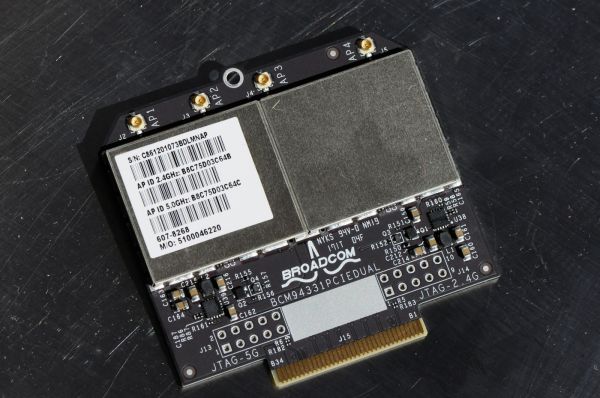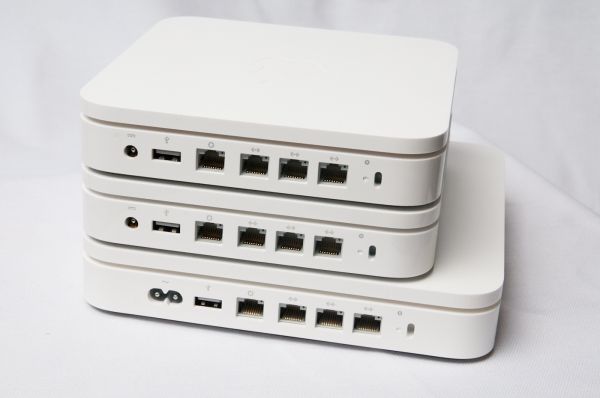Airport Extreme (5th Gen) and Time Capsule (4th Gen) Review - Faster WiFi
by Brian Klug on August 5, 2011 10:22 PM EST- Posted in
- Mac
- Airport Extreme
- Time Capsule
- WiFi
Conclusion and Final Thoughts
We’ve gone into extreme detail about the Time Capsule and Airport Extreme updates. I originally intended to have this posted with a hint of irony on WiFi day (8.02.11) but instead ended up spending that special day doing more testing and running even more instances of Iperf to make sure our numbers were solid. What’s changed between both previous generations is simple—the Time Capsule gets an official 3TB option, and both the Time Capsule and Airport Extreme now have a much more powerful, modern, and better-performing BCM4331 based WiFi stack.
The result of the move from Marvell to Broadcom is twofold. First, performance and range is definitely better thanks to more transmit power and the improved sensitivity afforded by newer generation chipsets. Second, the combination of lots of Broadcom in Apple’s hardware lineup (from the iPhone, iPad, and MacBooks, to iMac and Mac Mini) with Broadcom in the access point likely allows for the use of frame bursting or some other packet aggregation technique that speeds things up in some scenarios. It’s another example of how having that complete hardware control can in fact result in some benefit—in this case, faster WiFi.
Before this update, there were so many rumors about both iOS based Airport products, that the Time Capsule would cache software updates locally, and that the whole thing would somehow tie into Apple's iCloud solution. None of that exists right now, and it's looking like (for now) the rumor mill has some egg on its face. I waited patiently for Lion to launch and half expected things to turn on and render half of the review null; instead that day came and went without much change at all. As of this writing, the core functionality of the Airport line remains the same as it was before—sans any iCloud/iOS magic/local update caching.
There’s a stigma that Apple gear is more expensive, and for the 3TB Time Capsule that may be the case, but the Airport Extreme is actually right near where it should be. Take for comparison the Linksys E4200, which is a 2x3:2 device on 2.4GHz, and 3x3:3 on 5GHz, and also Broadcom based. That device runs for $179.99 and features similar functionality including a USB 2.0 port for sharing devices. At $179.00, the Airport Extreme offers full 3x3:3 on both 2.4 and 5GHz, albeit the E4200 does have considerably more Tx power, which we'll investigate in a forthcoming article.
I guess the reason that I personally use an Airport Extreme (in conjunction with another device for NAT) is that it's really one of a small number of 802.11n dual-band APs I've tried that actually works without locking up, becoming unstable periodically, dropping the session from overheating when being pushed to 100% for hours, or requiring a daily reboot. There are just so many other consumer level 802.11n APs that either fall short or are incredibly frustrating and unreliable. Thus far, I've been using an Airport Extreme Gen 5 and Time Capsule Gen 4 as my primary AP with over 12 devices attached to each one for the greater part of a month without a single instability. It's that kind of stability that really sells it for me, even with 3x3:3 out of the picture.
That kind of sums up WiFi in general—ideally, it should work and be something transparent to the user instead of a constant consideration. I wager the vast majority of Airport Extreme and Time Capsule owners have no idea what 3x3:3 is or how to even check their physical link rate, and for the most part that's a testament to how stable these devices are. Maybe that's the reason why Apple doesn't make a super huge note about changes like markedly improving their WLAN connectivity. One thing is for certain, Apple's wireless division is either playing it incredibly cool, or honestly not getting the credit it deserves.













90 Comments
View All Comments
Dug - Monday, August 8, 2011 - link
I wish they would allow some type of iTunes server on the Time Capsule. Then I could stream to everything else such as my Apple TV's without having a computer on.tsanga - Monday, August 8, 2011 - link
Brian,When you took apart your older Airport Extreme, did you notice if the antennas might have been improperly connected? Swapping antenna hookups could result in better 2.4 GHz performance:
http://www.smallnetbuilder.com/wireless/wireless-f...
Brian Klug - Tuesday, August 9, 2011 - link
I'm not entirely sold on that smallnetbuilder conclusion from a long time ago, to say the absolute least. I suspect the swappage they experienced could be explained in other ways. Everything appears to match the way it should be assembled in the present state.-Brian
CharonPDX - Monday, August 8, 2011 - link
I have both a first-generation "square" AirPort Express-n (10/100 Ethernet) and a second generation (that added Gigabit,) both of which are single-band-at-a-time only. (i.e. I have to choose between 2.4 or 5 GHz for my whole network, no mixing.)When using either one as the 'primary', if I use my maximum bandwidth and/or lots of open connections (I seed Torrents of Debian install images for alternate architectures, I swear!) it will lock up my internet connection every so often. I know it's not my cable modem or the cable company, because if I direct-connect my server, I have no problems. But through either AirPort, every half hour or so of heavy use, my internet will stall until I reboot the base station.
Have you performed any such testing? I haven't read any complaints about newer generation ones, but want to make sure.
Brian Klug - Tuesday, August 9, 2011 - link
You're using the device as a router in that configuration? I haven't heard of any such problems on the newer Gen 4 or 5, and I beat on mine pretty hard too and haven't seen it stall/hang.-Brian
weiran - Tuesday, August 9, 2011 - link
I have the original N Airport Extreme (100Mb) and I don't suffer the issue you have. I did have problems with using Time Machine with an attached disk over WiFi causing router lockups, I've since disabled it and the AE runs weeks without issues.davolfman - Monday, August 8, 2011 - link
It's nice to see somebody using the Sheeva SOC's in a shipping product. Too bad the RAM and Flash is so low or it would make a tempting (better designed) Sheevaplug replacement.bbarrera - Tuesday, August 9, 2011 - link
Great article, however please change "AFS" (whatever that is) to AFP.blueeyesm - Tuesday, August 9, 2011 - link
I use the "n" Express with a D-Link wireless router and I've had no issues via WDS. It connected and maintained a strong signal through two floors of a house, and through two walls (one of which was a fire-rated wall) of an apartment.pcworth - Tuesday, August 9, 2011 - link
I was wondering if there are any differences in connection reliability and WIFI speed continuity. I have a Gen4 Extreme that was purchased in February and it seems like I have recently started to get slowdowns on the internal network that are corrected by resetting the unit using the Airport Software.I originally owned the b/g spaceship and a b/g express, but when we bought our iPads in April 2010 we noticed that the airport station would stop connecting until the units were restarted. We tried working around this using power timers to restart the units, but in the end we gave up and bought a new Gen4 extreme. This problem has now stopped.
I have no idea whether the problem is a temporary glitch, a hardware problem, or my imagination. It does seem to affect the AppleTV most, which is at the opposite end of the house, because we find it sometimes takes a long time to start streaming from iTunes. When I go in and reset the unit, it seems to improve.
I was wondering if there are any measures of speed stability, and connection stability, to determine whether the Gen5 is more reliable than the Gen4 and worth thinking about for an upgrade?
Thanks!